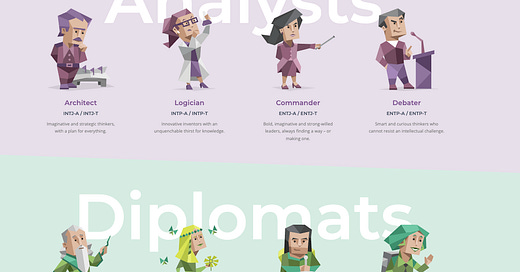Read the full piece on my website for the ~authentic~ feel. Otherwise, it’s also copied below for convenience:
The other day, under the cover of dim lights embedded in elegant wooden fixtures, we took impassioned guesses at each other’s MBTI’s. Personality types are an interesting way we use to pretend to be in control of the world and knowing of the world’s secrets. We bucket each other into divisions of 16 and 9 and 25 and 12, assigning occupations and strengths, disposition and spirit animals. We tend to like hard divides because they give us the illusion of truth. Even when we don’t believe in the underlying essence, we like to believe for fun. We choose to charge into the unknown relying on a faulty guide, maintaining a balancing act for our blissful ignorance.
an example of said buckets from a website to test your MBTI.
The past year I’ve been trying to get better at this act of charging headlong into undiscovered territories—relying on incomplete knowledge and uncertain assumptions. I think society designs itself around a standard path, and we’re taught to follow that path in every institution that we expose ourselves to. This is the get good grades, secure a stable and well-paying job, and start a wholesome family path. Society designs itself around this path: 4-year liberal arts degrees over trade schools, a nuclear family over extended families and neighborhood communities. It’s the road of constantly chasing a more perfect life. This sort of life is easier at first because it’s known what the right decision is at any given moment, but the problem is that the chase never ends. If you get good grades, you have to get into a good college. If you’re at a good college, then you better aim for a prestigious job. If you’re a successful professional, it’s time to get married and raise a family for the cycle to repeat itself all over again.
My journey towards being more comfortable with exploring uncharted paths stems from a questioning of this path. I think we all go through a breaking point where we consider rejecting this path in order to do what we want. We learn to follow our own instinct for what is right rather than relying on what everyone else is doing and striving for, to rely on our fallible internal compass for trudging forward. Sometimes that involves doing things that go against the grain and inherently in conflict with what the majority believe in. I’m interested in those moments of discordance, when someone’s inner instinct points in a different direction from the standard because it means you have to work that much harder to forge your own path…
The core difference between the two paths is that the first is all about following a laid-out path precisely, emulating existent trails and brush strokes, while the latter is all about forging a completely new path, taking inspiration and lessons from the attempts of those who came before. You risk more to gain more, and I think the best kinds of people and ideas are able to provoke others at the right times and in the right ways. A constant stability feels like a fake peace to me—we’re always changing along with our surrounding environments, and we need to be prodded in new ways to continue growing and adapting.
I want to be a provocateur in the ideas I explore and the art I create, to make media that feels textured and advance crazy ideas. I want my projects to push people to think in a different way and challenge them to reconsider reality in a new light. I want to make crazy ideas feel realistic, extreme fictional worlds feel relatable, complex creative environments feel approachable. There’s a philosophy in design that follows this principle, urging designers to provoke people with new possibilities. I want to be firm in what I think is right while being pliable according to new inputs, challenging but understanding, mindful of the past but unafraid to invent the future.
“The designer’s role in this is not like that of a doctor, prescribing cures for people’s ills; nor is the designer a kind of servant, developing technologies that people know they want. Instead, designers should be provocateurs, seeking out new possibilities for play and crafting technologies that entice people to explore them.”
Bill Gaver in Designing for Homo Ludens about designers being provocateurs to challenge people
A lot of the truth I’ve gathered from my life has been found in the area between the lines, the shades of grey, the paradoxes balanced in the mind. Maps are useful tools, but they’re not the territory. I think the hard divisions are useful tools, but there’s a real danger in how we’ve been trained to treat them as absolute law. I want to provoke people to explore those uncomfortable spaces, discordant notes, and rough edges because I think the frontier of those edges is our best bet towards creating the future.
This is the 89th installment in my experiment of publishing raw, lightly edited mini-essays every day towards achieving 100 public pieces. Check out the rationale and the full list here.





> A constant stability feels like a fake peace to me
🤯 This had not occurred to me before. Going to keep mulling over this 😆